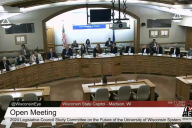You have /5 articles left.
Sign up for a free account or log in.
As Victor E. Ferrall Jr. offered a valediction for the liberal arts here, declaring them “over the brink,” colleagues at the recent Association of American Colleges and Universities conference in Washington, D.C., were abuzz designing its future: #libedunbound.
During a session entitled “Liberal Education Unbound: The Life of Signature Student Work in the Emerging Digital Learning Environment,” Rebecca Frost Davis of St. Edward’s University asked audience members to live tweet their reflections to the hashtag #libedunbound, to illustrate the productive potential of this networked back channel. The tweets posted during the session (including my own) were less than inspirational, perhaps because they were penned (thumbed?) on demand, in response to an assigned topic, “Where and from whom do you as a professional learn outside of the formal classroom or conference session?”
But the hashtag itself was inspired, as became evident during a later session, “The Future of Liberal Education in the New Learning Ecosystem,” led by Randy Bass of Georgetown University. Bass invited the panelists -- José Antonio Bowen, president of Goucher College; Gardner Campbell, vice provost for learning innovation and student success at Virginia Commonwealth University; and J. Elizabeth Clark, professor of English at LaGuardia Community College -- to move away from technology-driven questions about the future of higher education and instead pose a true design challenge: How would we reimagine and reconstruct the future (of) #libedunbound? As the speakers took on a series of probing questions about the possibilities as well as the threats “the new learning ecosystem” might represent, audience members’ -- and the panelists’! -- live tweets were projected onto a large screen. In this way, the panel’s official channel ran alongside its unofficial back channel.
The panel’s oral channel focused on a new vision of learning that will transform our conception of the liberal arts and higher education alike. Panelists spoke, for example, not just about students as content creators but about professors as “cognitive coaches.” They hypothesized that the role of faculty members might become to make their learning -- as process, not as an achieved state of being -- visible to students and to one another. How will we fulfill our responsibility to prepare students to “live fully in their time”? Are we preparing our graduate students to teach the future generations of networked learners?
As the panelists considered the conceptual parameters of the new learning ecosystem, the digital back-channel chatter -- a word that I find particularly suitable, as it captures the unscripted and unedited murmur of live tweeting -- both deepened and challenged the panel’s official argument.
Some tweets obliquely echoed the panelists, while others amounted to philosophical challenges and engaged fellow tweeters in a parallel conversation. One tweet asked, for example, if “it is possible to think deeply on [T]witter” (@noreen_o), while another (my own) mused that the concept of depth may have to shift in a networked environment. Particularly amusing was the banter about an imaginary gadget that a panelist described as the “academic [F]itbit,” which might provide future students and professors with a feedback loop on vital cognitive data. But even that jest quickly turned into a serious query: What questions would we ask about our learning and how would we measure it? How will we teach our students to read and monitor their own data?
We were, I admit, in a glorious echo chamber of like-minded liberal education enthusiasts, caught up in one of those electric moments of communal inquiry. We needed no convincing of the value of liberal education and we have not given up on its future. Ferrall is no doubt correct that we cherish liberal education because it helps students become “critical thinkers, able and eager to distinguish opinions from facts and prejudices from truths, alert to the lessons of history and unwilling blindly to accept unsupported claims and assertions.” But what the hundreds of tweets to #libedunbound also demonstrated is that we may benefit from the exercise of thinking about the future of liberal education away from the historically accurate but no longer productive dichotomy that juxtaposes it with vocational training.
In the knowledge economy, critical thinking and what we typically call skills are much more closely bound and more difficult to disentangle than they were at the inception of the liberal arts centuries ago or even in the relatively recent course of their 200-year history in U.S. higher education. As Gardner Campbell observed from the panel table, the new learning ecosystem offers innovative symbolic possibilities that liberal education has yet to explore. Our conception of the liberal arts will evolve with the learning ecosystem that it inhabits.
That is the key point Ferrall missed: liberal education has never been static. An argument that presents it as such has already given up on its key component: learning as a never finished process, always renewed and always contextual. #Libedunbound may be one way to capture this idea: the chatter to this hashtag indeed emphasized active liberal learners of the future over and above the nominalized form of liberal “education.”
Any valediction for the liberal arts should, like John Donne’s, at the very least “forbid[] mourning”: our historical moment can certainly be read as a “breach” of the venerable tradition, but it must equally be read as presenting an opportunity for its “expansion.” As Nicola Pitchford of Dominican University of California observed in a tweet from the session, “Instructional technology is for augmentation of what we do, not automation.” Any tradition worth preserving must live and breathe with the times, and we are responsible for its augmentation in the future.
“Valete artes liberales.” Not yet. And hearty welcome to #libedunbound.








